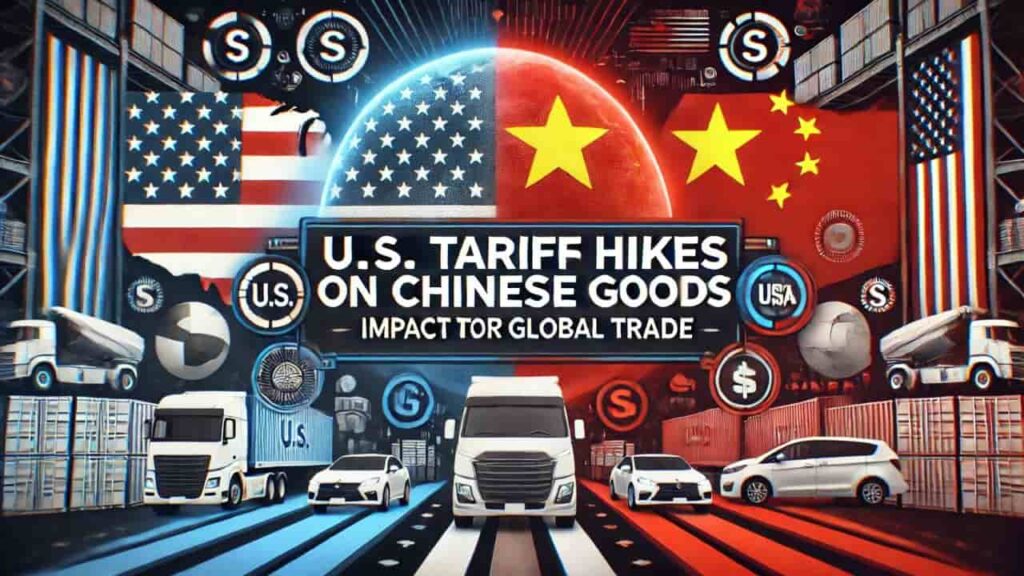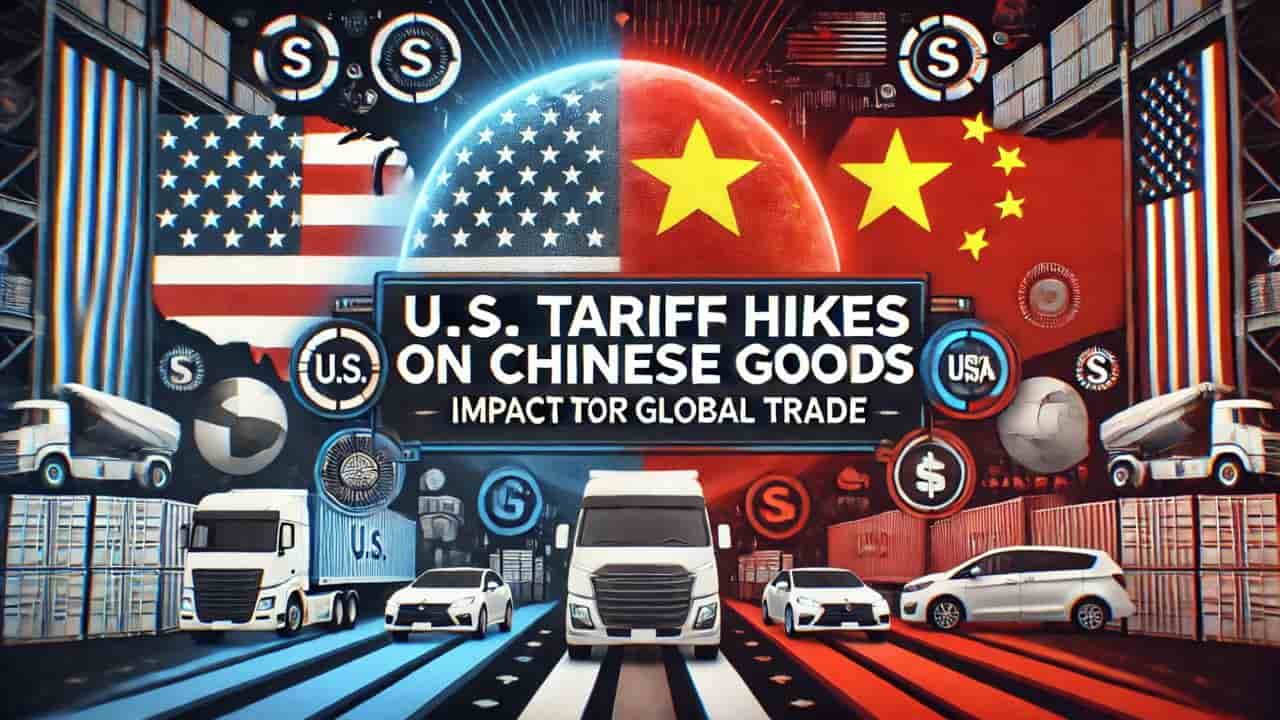U.S. tariff hikes, Chinese goods tariffs, U.S.-China trade war, September 27 tariff increase, Biden administration tariffs, Section 301 tariffs, USTR finalizes tariffs, steel and semiconductor tariffs, Chinese e-commerce loopholes, U.S.-China trade tensions, de minimis exemption abuse, Shein, Temu, U.S. economic policy
Explore the details of the U.S. government’s finalization of tariff hikes on Chinese goods, set to take effect on September 27, 2024. Learn how these tariffs impact strategic sectors like steel, semiconductors, and electric vehicles, and how the crackdown on e-commerce platforms is reshaping the trade landscape between the U.S. and China.

U.S. Finalizes Tariff Hikes on Chinese Goods: Implications for Global Trade and Economy
The ongoing trade tensions between the United States and China escalated once again on September 27, 2024, when the U.S. government officially finalized tariff increases on billions of dollars’ worth of Chinese goods. This decision marks the culmination of a four-year review of tariffs initially imposed during former President Donald Trump’s administration under Section 301 of the Trade Act. The latest tariff increases, primarily targeting strategic industries like steel, semiconductors, electric vehicles, and batteries, signal a continued push by the U.S. to address what it perceives as unfair trade practices by China.
The announcement, made by the United States Trade Representative (USTR) Katherine Tai, is set to have significant repercussions not only for the U.S. and Chinese economies but also for global trade and economic relations. The increased tariffs aim to curb the harmful policies and practices of the Chinese government, particularly in sectors where China is seen to have a competitive advantage through subsidies, intellectual property theft, and other forms of trade manipulation.
This article will delve into the details of the tariff hikes, the sectors most affected, the impact on U.S. businesses and consumers, and the broader implications for the global economy.
The Background: A Long History of U.S.-China Trade Tensions
The U.S.-China trade war began in earnest in 2018, when President Trump imposed a series of tariffs on Chinese imports under Section 301 of the Trade Act. The tariffs were introduced in response to accusations that China had engaged in unfair trade practices, including forced technology transfers, intellectual property theft, and industrial subsidies that gave Chinese companies an unfair advantage over their U.S. counterparts. In retaliation, China imposed tariffs on U.S. goods, leading to a prolonged trade war that saw both nations implement and adjust tariffs on a wide array of products.
Despite some signs of potential compromise, such as the Phase One trade deal signed in January 2020, tensions between the two economic superpowers remained high. The Biden administration, while taking a different approach to diplomacy, has continued to pursue a hardline stance on trade with China, aiming to protect U.S. industries and workers.
The latest round of tariff increases, announced in May 2024 and finalized in September, builds upon the existing trade policies established during the Trump administration. This move signals that the U.S. government remains committed to confronting China’s trade practices, particularly in strategic industries vital to both nations’ economic futures.
Key Sectors Affected by the Tariff Hikes
The tariff hikes finalized in September 2024 primarily target strategic sectors in which China has emerged as a global leader. These include:
- Steel and Aluminum: The U.S. has long expressed concerns over China’s subsidized steel industry, which has led to overproduction and depressed global prices. By imposing higher tariffs on Chinese steel imports, the U.S. aims to protect its domestic steel industry and prevent further erosion of market share.
- Semiconductors: As a critical component in modern technology, semiconductors are central to both national security and economic competitiveness. China has heavily invested in its semiconductor industry, prompting the U.S. to impose tariffs to limit China’s dominance in this field and encourage domestic production of semiconductors.
- Electric Vehicles (EVs) and Batteries: The transition to electric vehicles is a major priority for both the U.S. and China. However, China’s aggressive subsidies and dominance in the production of EV batteries have raised concerns in the U.S. Tariffs on Chinese electric vehicles and related components aim to level the playing field for American manufacturers and reduce reliance on Chinese imports in this growing sector.
By targeting these industries, the U.S. government hopes to counter China’s growing influence in areas crucial to the future of global trade and technological innovation.
The De Minimis Exemption: Cracking Down on E-Commerce Platforms
In addition to the finalized tariff hikes, the Biden administration has taken aim at Chinese e-commerce platforms for their alleged abuse of the de minimis exemption. The de minimis rule allows packages valued at less than $800 to enter the U.S. without paying import duties or taxes. This exemption, intended to simplify trade for small businesses and individuals, has been widely exploited by Chinese companies to avoid warehousing costs and deliver low-cost goods directly to U.S. consumers.
Companies like Shein, Temu, and Amazon sellers based in China have taken advantage of this loophole, shipping a vast number of cheap products to the U.S. without paying import fees. This practice not only undercuts U.S. retailers but also allows these companies to bypass regulations and safety standards that apply to other goods.
The crackdown on this exemption is part of a broader effort by the U.S. government to ensure that Chinese companies play by the same rules as American businesses. By targeting e-commerce platforms that exploit this rule, the U.S. is attempting to level the playing field and protect domestic industries from unfair competition.
Impact on U.S. Businesses and Consumers
The finalized tariff increases are likely to have a mixed impact on U.S. businesses and consumers. On one hand, domestic industries, particularly in sectors like steel and semiconductors, stand to benefit from reduced competition from Chinese imports. U.S. companies that have struggled to compete with China’s heavily subsidized industries may find it easier to maintain or even grow their market share under the new tariff regime.
However, consumers could face higher prices for goods that rely on Chinese imports. Electric vehicles, consumer electronics, and other products that use components from China could become more expensive as the cost of tariffs is passed on to consumers. This price increase could dampen consumer spending in certain sectors, potentially slowing economic growth.
Small businesses that rely on low-cost imports from China may also face challenges. Higher tariffs could increase their costs, making it harder to compete with larger companies that have more resources to absorb the price hikes. The Biden administration will need to balance the benefits of protecting domestic industries with the potential harm to consumers and small businesses.
Chinese E-Commerce Giants Hit Hard
The U.S. government’s decision to crack down on e-commerce platforms that exploit the de minimis rule has already had a significant impact on major Chinese companies. On the day the tariff hikes were finalized, U.S.-listed shares of several Chinese firms, including PDD (owner of Temu), Alibaba, JD.com, and Bilibili, saw sharp declines in value. This market reaction reflects investors’ concerns about the growing regulatory pressure on Chinese companies operating in the U.S. market.
By targeting e-commerce giants, the U.S. is sending a clear signal that it will not tolerate companies that exploit loopholes to gain an unfair advantage. This could lead to more stringent regulations on cross-border e-commerce and higher compliance costs for companies like Shein and Temu, potentially limiting their ability to compete in the U.S. market.
The Global Implications of U.S. Tariff Hikes
The U.S.’s decision to finalize these tariff hikes will likely have ripple effects throughout the global economy. As two of the world’s largest economies, the U.S. and China are deeply interconnected, and any trade disruption between them can affect global supply chains.
Other countries may find themselves caught in the crossfire as they navigate the shifting trade landscape. Nations that rely heavily on Chinese imports or exports to the U.S. may face increased costs or reduced demand. Additionally, the tariff hikes could further strain diplomatic relations between the U.S. and China, complicating negotiations on other critical issues such as climate change, cybersecurity, and global security.
In the long term, the continued imposition of tariffs could encourage the decoupling of the U.S. and Chinese economies, as businesses seek to diversify their supply chains and reduce their reliance on Chinese imports. This decoupling could reshape global trade patterns and lead to new alliances and partnerships.
Conclusion
The U.S. government’s decision to finalize tariff hikes on Chinese goods is a significant development in the ongoing trade tensions between the two nations. By targeting key sectors like steel, semiconductors, and electric vehicles, the U.S. aims to protect its domestic industries and reduce its reliance on Chinese imports. At the same time, the crackdown on e-commerce platforms that exploit the de minimis rule signals a broader effort to ensure that Chinese companies play by the same rules as their American counterparts.
While these moves may benefit U.S. industries in the short term, they also carry risks for consumers, small businesses, and the global economy. As the U.S. and China continue to navigate this complex trade relationship, the world will be watching to see how these tariff hikes impact the future of international trade and economic growth.
Read More
